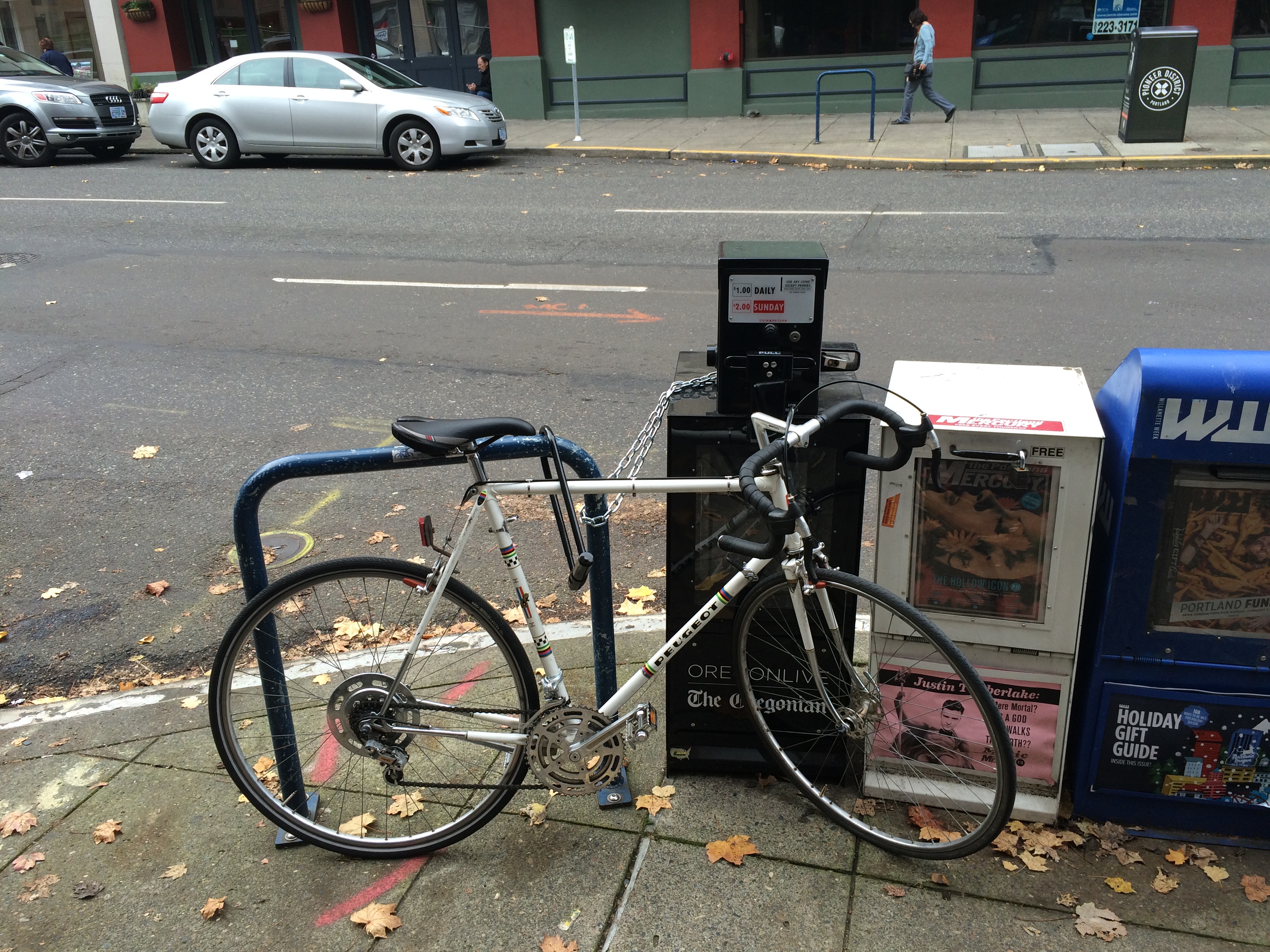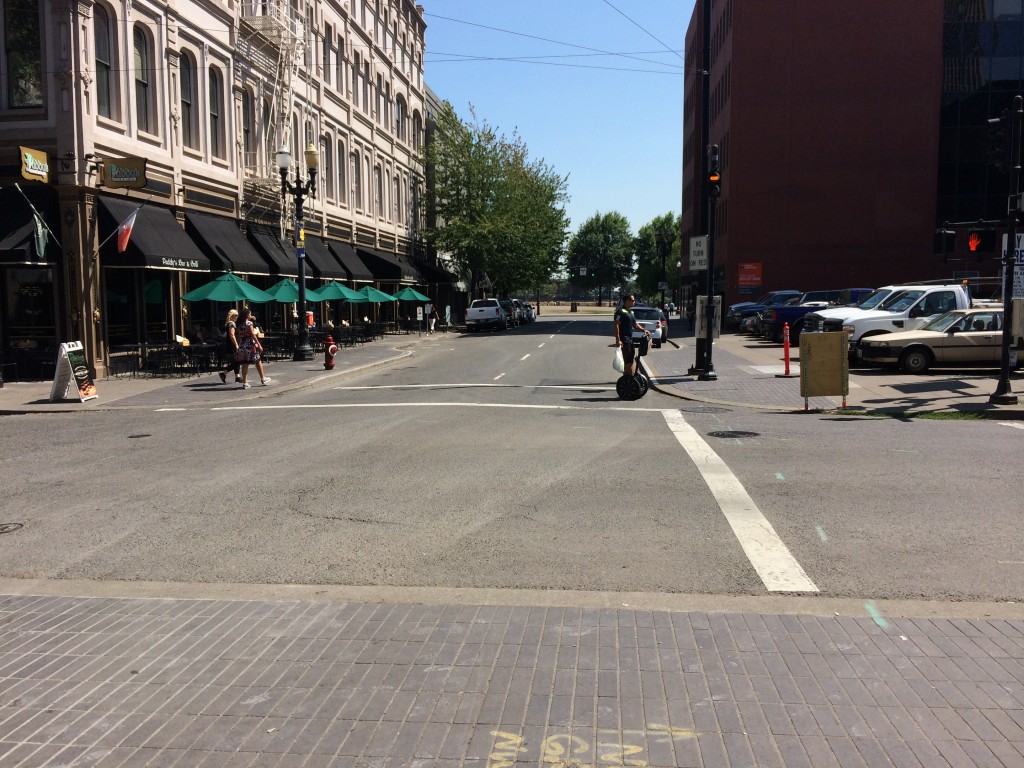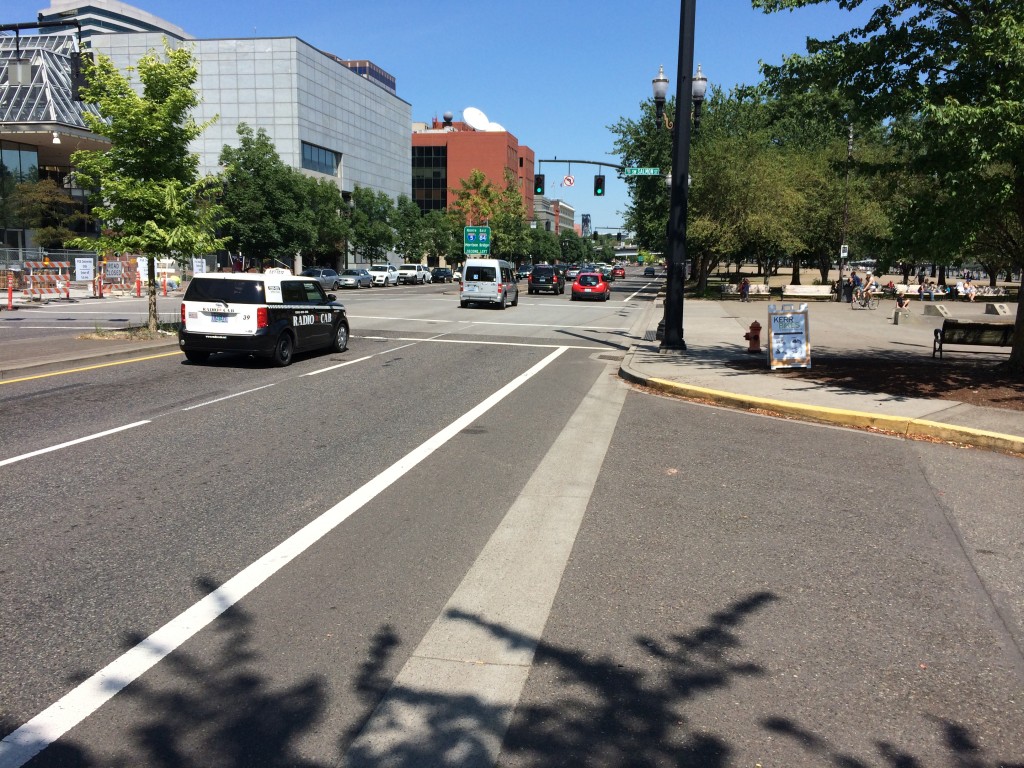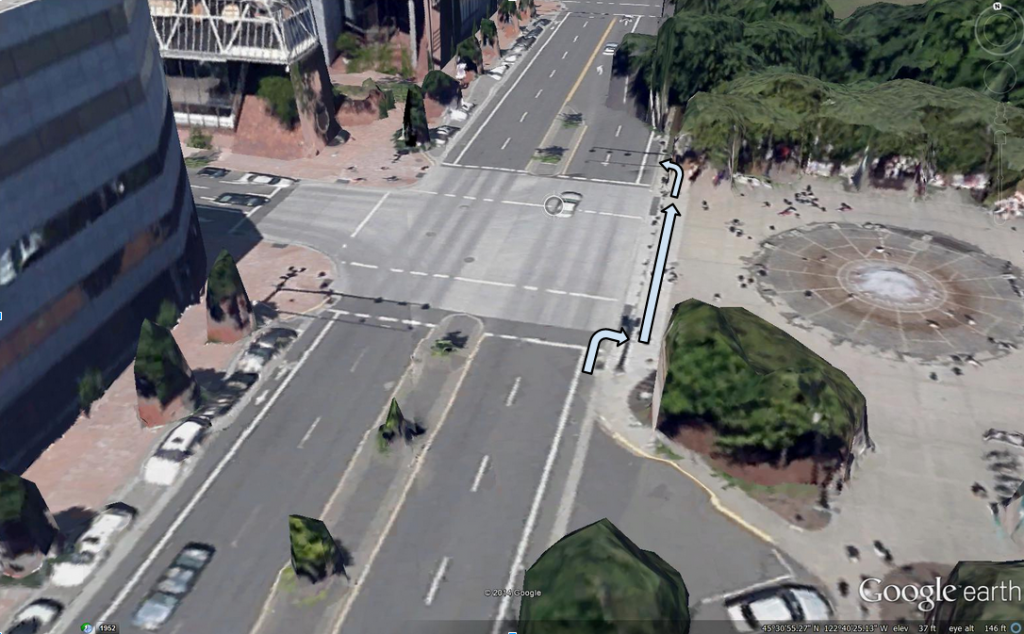A bicycle parked blocking access to newspaper boxes, in violation of Portland city Code 16.70.320(A).
Oregon’s state statutes do not contain any laws that dictate how a person is supposed to park a bicycle. This has resulted in many cities and towns of Oregon drafting their own bicycle parking ordinances. In some of those cities a violation of the ordinance can result in an illegally parked bicycle being impounded . Below I have included the bicycle parking ordinances for the 13 largest cities in Oregon.
Portland
Portland City Code 16.70.320 Operating Rules
No person may:
A. Leave a bicycle so that it obstructs vehicle or pedestrian traffic on a roadway, sidewalk, driveway, handicap access ramp, building entrance, or so that it prevents operation of a parking meter or newspaper rack;
B. Leave a bicycle secured to a fire hydrant or to a police or fire call box;
C. Leave a bicycle on private property without consent of the owner or legal tenant. Consent is implied on private commercial property;
D. Leave a bicycle on a street or other public property for more than 72 hours[.]
Salem
Salem City Code 101.150 Parking of Bicycles
It shall be unlawful for any person to leave a bicycle upon any sidewalk, except in a bicycle rack. If no rack is provided, he shall leave the bicycle so as not to obstruct any roadway, sidewalk, driveway, or building entrance; nor shall any person leave a bicycle on public or private property without consent of the person in charge or the owner thereof.
Eugene
Eugene City Code 5.400 Operating Rules
. . .
(2) No person may park a bicycle in or near a public thoroughfare or place in such a manner as to obstruct traffic or endanger persons or property.
Eugene City Code 5.420 Impounding of Bicycles
(1) A bicycle left on public property for a period in excess of 24 hours may be impounded by the police department.
(2) In addition to any citation issued, a bicycle parked in violation of this chapter may be immediately impounded.
(3) If a bicycle impounded under this chapter bears an Oregon driver’s license number, or other means of determining its ownership exist, the police shall make reasonable efforts to notify the owner.
(4) A bicycle impounded under this chapter which remains unclaimed shall be disposed of in accordance with the city’s procedures for disposal of abandoned or lost personal property.
Gresham
Gresham Revised Code 8.70.040 Misuse of a Bicycle or NonMotorized Vehicle.
No person shall leave a bicycle or non-motorized vehicle:
(1) in a manner which obstructs a street. sidewalk, driveway or building entrance;
(2) on private property without the consent of the person in charge or the owner of the property;
(3) on public property for a period in excess of 18 hours; or
(4) in a public parking lot in a vehicle parking space. A bicycle may only be parked in a public parking lot where special provision has been made for bicycles, in the stand, rack, or other bicycle holder
Gresham Revised Code 8.70.050 Impoundment.
(1) A bicycle or non-motorized vehicle in violation of GRC Article 8.70 may be immediately impounded by the police department.
(2) If a bicycle or non-motorized vehicle impounded under this section is licensed, or other means of determining its ownership exist, the police shall make a reasonable effort to notify the owner.
(3) A bicycle or non-motorized vehicle impounded under this section that remains unclaimed for a period of more than 60 days may be disposed of in accordance with GRC Article 2.81, the city’s procedures for disposal of abandoned or lost personal property.
(4) A bicycle or non-motorized vehicle impounded under this section may be held until the person using the device at the time of the impound is acquitted or provides proof that
security deposit or the fine upon conviction has been paid, unless otherwise ordered by the
Circuit Court or other court of competent jurisdiction.
Hillsboro
Hillsboro Municipal Code 8.28.100 Bicycle parking
A. It is unlawful to park or leave a bicycle upon the sidewalk, except in areas designated under HMC 8.28.100(B).
B. Designated areas for the parking of bicycles and only bicycles are as follows:
1. At the curb on the street and sidewalk, beginning at the intersection of the north boundary of Main Street and the west boundary of N 3rd Street, thence north 20 feet;
2. At the curb on the sidewalk beginning at the point on the north side of E Lincoln Street that is 55 feet east from the easterly boundary of N 2nd Avenue, thence east 20 feet; and
3. During the months the municipal swimming pool is in operation and while bicycle racks are maintained in the street for parking bicycles:
a. On the street on the easterly side of S 9th Avenue beginning at a point 10 feet south of the south boundary of E Cedar Street, thence south 35 feet; and
b. On the street on the southerly side of E Cedar Street, beginning at a point 15 feet east of the east boundary of S 9th Avenue, thence east 45 feet.
C. The manager will cause the appropriate number of bicycle racks to be erected, kept and maintained, each with the proper marking by signs or painting, upon each of the areas under HMC 8.28.100(B).
Beaverton
Beaverton City Code 6.02.430 Impounding of Bicycles.
A. It shall be unlawful to leave a bicycle on public or private property without the consent of the person in charge or the owner thereof.
B. A bicycle left on public property for a period in excess of 72 hours may be impounded by the police department.
C. If a bicycle impounded under this section bears an Oregon driver’s license number or is licensed by this City or another City or other means of determining its ownership exists, the police shall make reasonable efforts to notify the owner.
D. An impoundment fee set by Council resolution shall be charged to the owner of a bicycle impounded under this section except where the bicycle was stolen.
E. A bicycle impounded under this chapter which remains unclaimed for 60 days, shall be disposed of in accordance with BC 2.05.010 through 2.05.026.
Bend
Bend City Code 6.35.000 Bicycle Operating Rules.
Except for bicycles operated by on duty law enforcement personnel:
A. Bicycles shall be parked so they do not obstruct a roadway, sidewalk, driveway or building entrance.
. . .Bend City Code 6.35.005 Impounding Bicycles.
A. A bicycle left on public property for more than 24 hours may be impounded by the Police Department.
B. If a bicycle impounded under this code is registered, or other means of determining its ownership exist, the police shall make a reasonable effort to notify the owner. No impounding fee shall be charged to the owner of a stolen bike.
C. A bicycle impounded under this code and remaining unclaimed shall be disposed of in accordance with City procedures for disposal of abandoned or lost personal property.
D. Except as provided in subsection (B) of this section, a fee established in the City’s Fee Resolution shall be charged to the owner of a bicycle impounded under this section.
Medford
None
Springfield
None
Corvallis
Corvallis City Code 6.10.060.150
No person shall park a bicycle upon a street or upon a sidewalk except in a rack to support the bicycle or against a building or at the curb, in such a manner as to afford the least obstruction to pedestrian traffic.
Albany
Albany City Code 13.40.150 Parking
No person shall park a bicycle upon a street or upon a sidewalk except in a rack to support the bicycle or against a building or at the curb, in such a manner as to afford the least obstruction to pedestrian traffic.
Tigard
Tigard Municipal Code 10.36.180 Parking Restrictions
From and after December 18, 1967, it is unlawful for any person to park or leave a bicycle upon the sidewalk within the City; except in areas designated by ordinance, which areas shall be properly marked by signs or painting and provided with racks for parking bicycles.
Lake Oswego
Lake Oswego Code 32.10.810 Requirements for Operation of Bicycles Generally.
. . .
7. Obstructing Traffic – No operator of a bicycle shall leave his bicycle lying or standing in such a manner that shall hinder or impede pedestrian or vehicular traffic upon the sidewalks or paths or upon the highways or alleys or public ways within the City, but shall take proper care to see that his bicycle is so placed as to avoid annoyance and danger of accident during his absence from it.
8. Use of Designated Bicycle Stands – The City may designate such place or places within commercial zones exclusively for parking of bicycles and no person shall stand, park or leave any bicycle on the highway or alley or sidewalk within 200 feet of any such place designated exclusively for bicycle parking by the City.
Lake Oswego Code 32.10.815 Impounding Bicycles.
1. No person shall leave a bicycle on private property without the consent of the owner or person in charge. Consent is implied on private business property unless bicycle parking is expressly prohibited.
2. Unless bicycle parking is expressly prohibited on public property, a person shall leave a bicycle in a bicycle rack, if provided, or in accordance with section LOC 32.10.810(8).
3. A bicycle left on a highway or other public property for more than 24 hours may be impounded by the police department.
4. In addition to any citation issued, a bicycle parked in violation of this chapter that obstructs or impedes the free flow of pedestrian or vehicular traffic or otherwise endangers the public may be immediately impounded by a law enforcement officer.
5. If a bicycle impounded under this chapter is licensed, or other means of identifying its ownership exist, the police shall make reasonable efforts to notify the owner.
6. A bicycle impounded under this section that remains unclaimed after 30 days shall be disposed of in accordance with LOC 14.04.120.
7. Impoundment under this section shall be done in accordance with the provisions of LOC 14.04.110, et seq.




